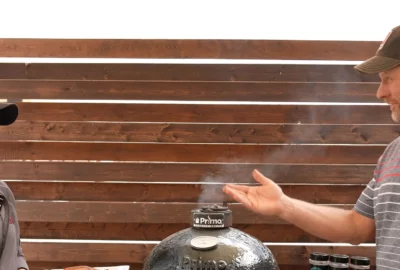Process, Smoking & Grilling World
Lump or Briquette? What is the Difference?
Which is better briquette or lump charcoal? Pellets or Stick burners? Offset or Drum? Kettle or Kamado?? Questions like these have been the topic of great discussion amongst my friends and co-workers at FireBoard Labs. These spirited yet good-natured discussions are often left with no definitive agreement on which is best.

Chimneys loaded with two different types of charcoal to conduct a taste test of which is best.
This has inspired me to create a series of posts that investigates the most common decisions facing consumers in the barbecue marketplace. The primary interest is to record some honest reactions to the variety of cooking methods consumers are faced with. Then passing the results along to assist in some decision-making. At FireBoard Labs we are lucky enough to have at our disposal a variety of popular smokers, and an award-winning competition smoker/BBQ rest. Two key elements to running a test such as this.

The goal of this test is to illuminate differences and preferences for those interested in improving their smoking capabilities. Participating in this taste test are professionals in the Barbecue industry, my co-workers at FireBoard Labs! We are a company founded on BBQ and staffed with lovers of BBQ. Not to mention we are headquartered in a city where BBQ is quite popular.
Testing Method

Color-coded toothpicks were used to tell the difference between the two test samples. Briquette was multicolor and Lump was regular toothpicks.
Today we performed a head-to-head blind taste test, comparing two different varieties of charcoal: lump and briquette. Two identical Weber Kettle Grills with Weber Char-Baskets were used to slow-cook fresh, never been frozen boneless-skinless chicken thighs. To regulate temperature, both grills were outfitted with FireBoard 2 Drive and Blower fans, with a set temperature of 300ºF. Both pans of chicken were lightly seasoned with the same rub. The chicken was cooked to an internal temp of 165ºF, and then cut into sample sizes susers of to be able to report to our users what the best course of action is for our customers the best tasting. 
Hannah took our taste test of lump vs. briquette charcoal VERY seriously.
Results

After my co-workers decided which sample they preferred, the would drop the tooth pic of their choice into a cup. Once everyone had a chance to test the chicken the pics were tallied up.
In this informal taste test briquettes were chosen by more of my co-workers 10-6 over lump charcoal. The common response was that the chicken thigh cooked with briquettes had a more desirable balance between smoke and flavor.
Some End Notes
With briquettes being the popular choice of our group, a key takeaway would be that the lump had a smoke level that interfered with the seasoning. Results will vary depending on the amount of seasoning and of course the choice of protein. Aside from flavor, it is also worth mentioning that some of my co-workers had other reasons to use one over the other. First is the price, which varies but for this test, I paid $0.56/lb for Kingsford briquettes and $0.83/lb for Frontier lump charcoal, so the briquettes were slightly less in price, barely worth mentioning but a difference nonetheless. Another comment was how much less ash lump charcoal generates over briquettes, which makes for easier cleanup. If the nominal difference in price and the flavor wasn’t essential, I could see how this would be an important factor in selecting your regular charcoal. 
Graphs from the FireBoard App testing Lump vs. Briquette charcoal, with a green dot marking the start of cook time. Both fuels appear to show similar efficiency results. However, it is worth mentioning that the Weber Char-Basket is a small volume, and that given a larger firebox the irregular sizes of lump charcoal would reflect greater variations in a graph such as this.

Consider chicken for any taste test your may be thinking about conducting yourself. FireBoard’s test comparing lump and briquette charcoal used boneless-skinless chicken thighs for the light tissue of the protein. Maybe more importantly the regular consistency of this meat serves as a fantastic blank canvas for subtle flavor variations. It will most likely be our go-to protein for any future taste tests that we conduct…briquette vs. pellet smoker??









11 Comments
Eric
Cool test, nice work! It would be interesting to see how it would go in an offset barrel smoker. Same with keeping the skin on the chicken. The Weber is a great grill, I can see how it would put a lot of smoke on the meat. My offset barrel has a lot of volume. I also leave the skin on which could cut down on the smoke. These two combined could lead to a different outcome.
See, it was a thought provoking test. Well done!
Jeff Nichols
Hey Eric, Thanks for the comment! A barrel would be a lot of fun. We don’t own one, but I am sure if I put the word out we could find a loaner.
Art
Hi Jeff,
Another interesting comparison would be mesquite briquettes Vs., lump mesquite.
Jeff Nichols
Thanks Art, I will add it to our list.
Tim
Comment / question related to your mention of lump cost vs. briquette cost.
After cooking, did you attempt to smother the fire to retain unused fuel for a future cook? IOW, if the briquettes burn up completely but a portion of the lump remains, would the cost comparison need adjustment? Or maybe briquettes wont burn up when smothered and my assumptions are garbage.
Thanks for posting your test!
Jeff Nichols
Hey Tim,
Thanks for asking and no I didn’t. I was so excited to get the chicken to our taste testers, that I let both burn out.
On a related topic, I’ll reiterate that the ash left behind from the two is quite different. The ash from lump charcoal is very light and flakey like that of a cigar. While briquettes leave behind a substantially larger amount of a gritty/sandy sort of ash.
Eric Gittelman
Interesting results. Ty.
Tom
Next time use a lump that isn’t the bottom of the barrel in quality. Kingsford is a really nice briquette, but Frontier lump is pretty much c__p compared to Jealous Devil, KJ, Fogo, etc. Even B&B or Royal Oak, second tier lump, would have been better.
Jeff Nichols
Hey Tom! Thanks for bringing this up. I initially wanted to use Royal Oak, but after not being able to find it on the shelf, I opted for what was readily available. Sounds like a basic vs. boutique lump test might needed 🙂
Pat
Hi guys-
Great effort, but major science fail. You did everything right as far as controlling for bias right up until you decided to use different toothpicks for the two treatments (charcoal types). By choosing multicolor for briquette and plain for lump, you completely violated the concept of blind sampling, which requires that none of the participants know which of the treatments they are tasting at any time, or even whether they are different at all. Of course everyone is going to assume they are going to receive both, but the toothpicks must be identical except perhaps for a number on each (which should be random to avoid inferring treatment or causing bias). Your different toothpicks not only gave away the identities, they potentially induced bias (some people might think colored picks are prettier or more festive or make food taste better). Also, none of the tasters should see the other taster’s votes or hear their opinions until after they have voted.
To do this right:
Same kind of toothpicks, w/ random numbers or RFID tags attached
Don’t display all samples grouped on separate plates for everyone to see.
Everyone gets a single plate w/ two samples (one of each treatment, randomly arranged)
No talking if everyone tastes together
Use an opaque container with a hole on top to accept the picks for voting.
Otherwise your results are potentially invalid and you’d never get them published in a reputable journal.
Rock on!
-pat
Jeff Nichols
Hey Pat, thanks for the constructive criticism! While scientific journals were not the scope of this blog post, I sincerely appreciate the help in improving about content and will adopt your suggestions the next time we do a comparison test.